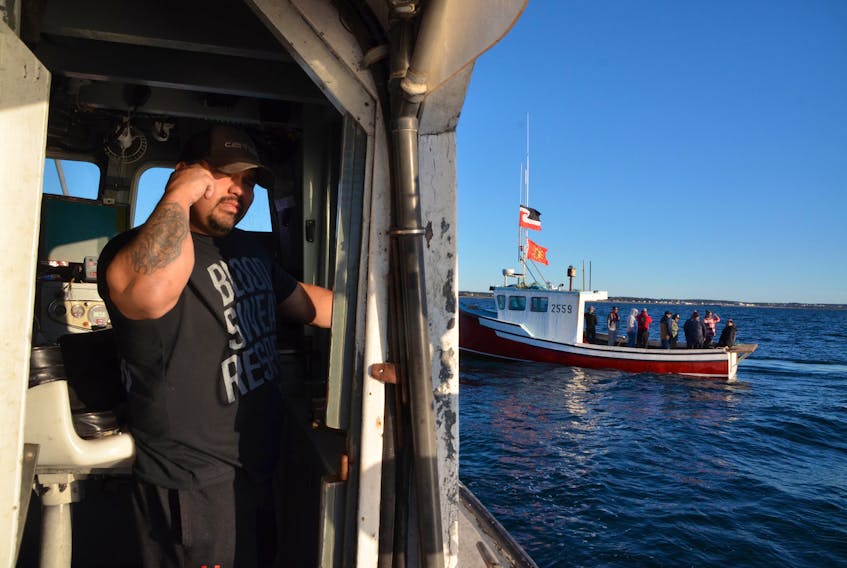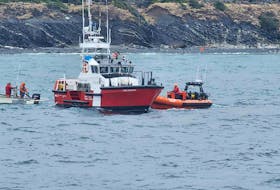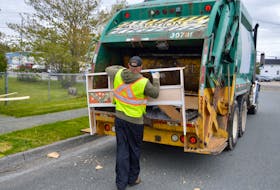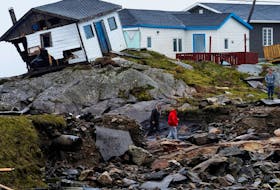SAULNIERVILLE, N.S. — A Coast Guard cutter and two helicopters (one RCMP, one DFO) provided little more than backdrop scenery to the boiling tensions on the Acadian shore Monday.
Both the First Nations encamped behind a barricade at the Saulnierville Wharf and the predominantly Acadian local fishermen with their own roadblock at the Meteghan wharf 14 kilometres away called on the federal authorities to uphold the law.
But whose law do they uphold?
Successive federal fisheries ministers have kicked the issue down the election cycle by providing commercial licenses to First Nations bands without negotiating the Supreme Court of Canada acknowledged right of individual Mi’kmaq to make a moderate livelihood off of natural resources.
The vacuum left by their inaction is being filled with threats, flares and rubber bullets.
The worry of both the Mi’kmaw and Acadian communities on this shore is that the situation will get worse.
“Hey, what’s up big guy,” reads a message sent Sunday to a commercial fisherman that has been seen by The Chronicle Herald.
“What’s ur address? I got 3 and I’ll find out which ones yours today. It’s all fun and games until someone’s house goes up in flames with everyone sleeping inside.”
The threats have gone both ways.
Each trap the First Nations members drop in St. Mary’s Bay, meanwhile, is being hauled and disabled by the commercial fleet floating within view of the Saulnierville wharf.
"DFO is letting them get away with committing a crime,” said Sipekne'katik Chief Mike Sack.
Asked if federal Fisheries Minister Bernadette Jordan had offered anything that would lower the temperature on the water, Sack replied, “No, she committed to another talk today or tomorrow.”
THE BAY

Digby Neck reaches down from mainland Nova Scotia and with help from Long and Brier Islands points southwest toward the Gulf of Maine.
Like its big neighbour, the Bay of Fundy, St. Mary’s Bay creates turmoil to create life.
Twice daily it squeezes the onrushing tide between Cape St. Mary’s and Brier Island. The flood’s churn mixes nutrients in the water column, bringing them into the light to form a breeding ground for tiny plants and animals called plankton and phytoplanktons.
It was to the ungenerous land overlooking St. Mary’s Bay that in the mid 1700s the English colonial government allowed the Acadian families to return to Nova Scotia, after having previously driven them off the best farmland.
Still here on this shore of brightly painted little wooden houses and big churches, they are acutely aware they were pushed here and now they feel they’re being pushed out of the bay that offered the economic opportunity the land refused.
“There’s nothing left at this end of the province, “ said Cindy Comeau.
“Forestry’s gone, the mink farms are gone, and when this fishing is going there’ll be nothing left for our children.”
With her husband, Joel, she fishes lobster from the last Monday in November through the calendar until May.
Until two years ago, they fished the majority of their traps about 20 minutes from the Meteghan wharf.
But fewer lobster in the bay has meant the past two years they’ve been steaming out to fish their traps in the Gulf of Maine.
They and many of the other 150 commercial lobster licence holders allege that fishing outside of the season over recent years by Mi’kmaw has resulted in a 68 per cent decrease in catches.
According to their own figures, landings in St. Mary’s Bay have gone down from 1,720 tonnes in 2017 to 650 tonnes in 2019.
The Chronicle Herald tried to verify those numbers with Fisheries and Oceans, but only received a response that it couldn’t break down the landings data for the much broader Lobster Fishing Area 34.
Just over 22 million kilograms of lobster, valued at $402 million, were landed in LFA 34 in 2019.
At the individual level, fishermen in St. Mary’s Bay average about 47,000 pounds a season. At $6 dollars a pound, that’s about $300,000 per enterprise. Licences in the bay go for about $800,000 and boats can cost about a million dollars.
They also have to pay fuel, insurance, repairs and crew.
While previously the Comeaus would be back at the wharf each day by mid-afternoon, their trips out from the Meteghan wharf now last two to three days.
Winter fishing is hard, dangerous, miserable work.
“And here we get portrayed in the media like we’re greedy fishermen,” said Comeau, who fishes crab and ground fish through the summer months.
“We work our asses off for that $70,000 truck.”
Nation to Nation

This is Levi Paul Sr.’s bay too.
For 27 years he’s been coming here from the Sipekne'katik First Nation, 277 kilometres away, seasonally to fish lobster.
On Sunday evening his wife, Nikita, was sewing new webbing into the lobster traps non-aboriginal fishermen had used to build a wall across the road leading to the Saulnierville wharf earlier that week while Paul tinkered with the Seabug’s overheating diesel motor.
Well past 30 years old, the Seabug was one of the more modern vessels at the Saulnierville wharf on Sunday.
Despite its modesty it represents a big step toward financial independence for Levi, Nikita and their children who will join them fishing.
“There is no opportunity in Shubie. Our community is in poverty,” said Levi.
“Three to four families in a house. We’re tired of it. We’re just here trying to make that change.”
Much like the Acadians along this shore, the reserves the Mi’kmaw were forced onto were composed of land not wanted by the English crown.
“Oh yeah, we steamed her right down the (highway) 102,” laughed a relative helping with the traps when asked how they’d got the Seabug to Saulnierville.
It’s funny because Sipekne'katik is not located next to a fertile resource like St. Mary’s Bay.
Paul Sr. was 11 when his father first brought him to camp out on the beach in Sandy Cove, farther up the bay, and go collect lobster in the shallow water.
Lobsters migrate into the bay through May and June to molt. They shed their shells and hide from predators among the rocks littering the bay’s bottom.
They feed and grow all summer in the nutrient rich waters.
It makes them much easier to catch than in November when, armoured with new shells, the majority of them start migrating back out toward the deeper waters of the Gulf of Maine.
Then came the 1999 Marshall decision.
Armed with a Supreme Court of Canada decision saying they had always had a right to make a moderate livelihood off of resources, Levi Sr. tried to move to the wharf at New Edinburgh.
They got a similar reception to Mi’kmaw and Maliseet across Atlantic Canada.
Traps were cut and boats were burned as the communities that had come to rely on the fishery opposed what they considered new competitors for a limited resource.
For their part, and with the Supreme Court’s backing, the Mi’kmaw contended they had just been denied the access previously promised by the English Crown in the treaty of 1762 to resources they had sustainably harvested for thousands of years.
Fisheries and Oceans responded with the Marshall Response Initiative, which bought up hundreds of commercial licences and distributed them, along with boats and training to First Nations.
Over the decade that followed, about $545 million would be spent on the program and those that followed it.
But the contracts signed in providing those commercial licences stated that they did not count toward achieving the right of individual Mi’kmaw to make a moderate livelihood off the resource.
With more Mi’kmaw boats taking to the water over recent years to pursue a moderate livelihood fishery, DFO came knocking with a new program that looked a lot like the Marshall Response Initiative.
This one would see 322 previously retired licences issued to bands in Atlantic Canada and money to gear up to fish them. But according to Mi’kmaq Rights Initiative lawyer Bruce Wildsmith the deal signed by two First Nations in New Brunswick included the caveat that they would put their efforts to pursue a separate moderate livelihood fishery on ice for 10 years.
He wouldn’t say what was offered to the First Nations in Nova Scotia, but they rejected it.
On the Water

With hundreds Mi’kmaw from around Atlantic Canada cheering from the Saulnierville wharf, Terence Augustine steamed the Lady Carol I out into St. Mary’s Bay on Sunday evening.
Tied together by rope and with a buoy at each end, his 10 baited trap constituted one set.
Of the five sets he’d dropped earlier in the week, four had been seized by the commercial fleet.
“All the (Mi’kmaw) guys around here can’t afford a big ass boat,” said Augustine.
And so, he explained, fishing in the rougher winter weather is not an option for the Mi’kmaw fleet.
Augustine, with his captain papers and the new to him Lady Carol I (built in 1988), doesn’t need to be Saulnierville.
He leases one of the band-owned lobster licences and fishes it out of Wedgeport.
He’s also worked for years on non-aboriginal boats.
Even as he comes out each day in support of his fellow Mi’kmaw, he talks with the non-aboriginal fishermen in the opposing fleet on his cell.
“You should have seen them coming at us this morning,” said Augustine.
Encounters between the two fleets have resulted in a lot of accusations.
The First Nations allege flares were fired at them by commercial boats in the dark while non-aboriginal fishermen allege they were shot at with rubber bullets.
They’ve also led to the commercial fleet hauling what they estimate to be 4,000 First Nation lobster traps out of the bay since last Thursday.
“This was untagged, illegal gear,” said Bernie Barry, president of the Coldwater Lobster Association, on Monday.
“The entire bay was saturated with it.”
He says the pots had non biodegradable rings holding in place the escape hatches – which would result in lost gear continuing to catch lobster – and other problems with the traps used by native fishermen.
He showed pictures on his cellphone of lobsters shoved on spikes as bait and the stainless steel rings.
“No one is taking a step back here,” said Barry.
“We’re not taking a step back till everybody leaves.”
The traps Augustine was setting on Sunday night had tags issued by his band, appropriate escape hatches and bioderadable fasteners.
“We’re following all the rules (the commercial fishermen do),” said Augustine.
He doesn’t consider there to be anything illegal about his gear or the moderate livelihood fishery.
Asked how long he’d keep coming out and getting his gear cut.
“As long as it takes,” he said.









